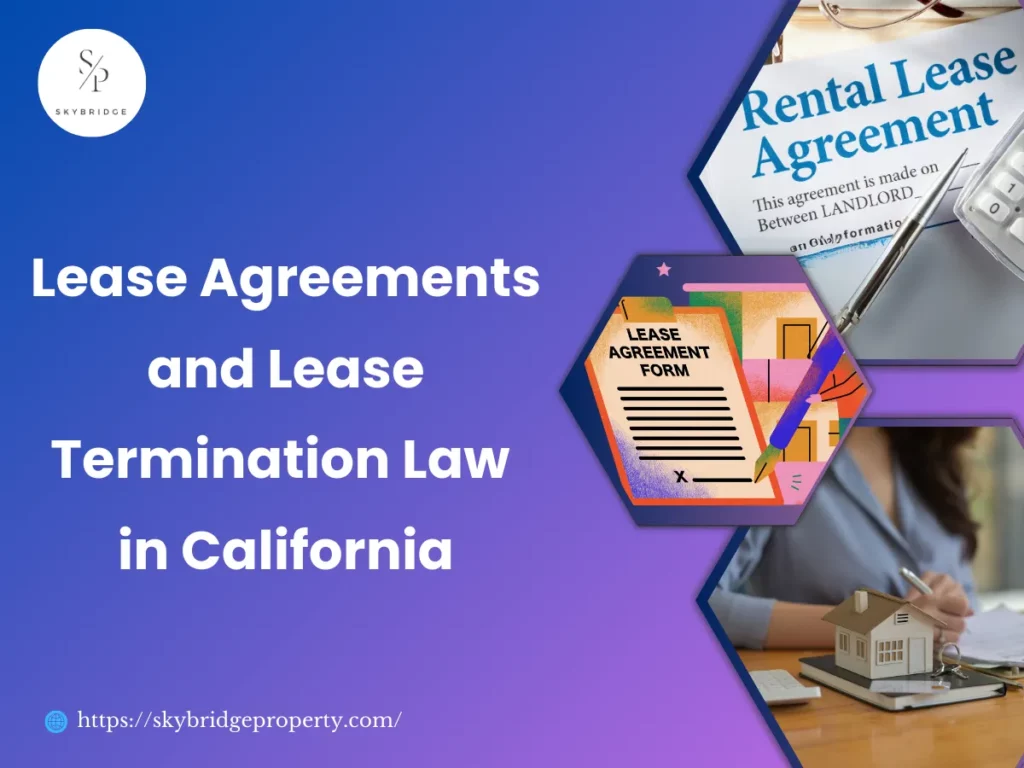In California, lease agreements and their termination are governed by state laws and local ordinances, which ensure fair practices for both tenants and landlords. A valid lease must include essential components such as the rent amount, payment terms, and security deposit limits. Landlords are required to provide specific disclosures like mold, lead paint, and bedbug history, along with information on smoking policies and demolition plans. California law also defines rules for security deposits (maximum two months for unfurnished, three for furnished units) and outlines the processes for lease termination. Rent control and just-cause eviction laws, under AB 1482, limit rent increases and prevent arbitrary evictions. Additional habitability requirements and anti-discrimination laws ensure safe, fair housing. For commercial leases, terms are more flexible but still regulated under the California Business and Professions Code. Understanding these components helps both tenants and landlords avoid penalties and ensures compliance with California’s comprehensive rental laws.
Lease Agreements laws in California
California’s lease laws, as outlined in the California Civil Code (Sections 1940–1954.05), provide a detailed framework for both residential and commercial leases. These regulations exist to ensure that both landlords and tenants are protected, and that all parties operate under fair and clear terms. The rules cover everything from the fundamental structure of a lease to how disputes are resolved, aiming to maintain balance in landlord-tenant relationships. With a particular focus on tenant protection, the laws aim to prevent unfair practices and guarantee that both sides honor their obligations throughout the lease’s lifecycle.
Required Disclosures in Residential Leases
One of the key components of lease agreements in California is the requirement for specific disclosures. Landlords must inform tenants about various issues that may affect their health, safety, or living conditions. These include:
- Lead-based paint: A mandatory disclosure for homes built before 1978, as exposure can pose serious health risks.
- Mold: If mold is known to exist, it must be disclosed.
- Bedbug infestation: Landlords must provide information if the property has a history of bedbug issues.
- Smoking policy: Tenants must be made aware if smoking is restricted on the premises.
- Security deposit details: Including the amount and terms of its return when the lease ends.
- Notice of demolition or repairs: If the landlord plans substantial renovations or plans to demolish the property.
- Rent control or just-cause eviction notices: Under AB 1482, applicable if the property is subject to rent control or specific eviction requirements.
Failure to provide these disclosures can invalidate parts of the lease and may result in penalties for the landlord. It’s vital for tenants to review these disclosures carefully to understand their rights and avoid future disputes.
Security Deposit Limits
California law places specific limits on the security deposit for residential leases. For unfurnished units, the maximum deposit cannot exceed two months’ rent, while for furnished units, it can be up to three months’ rent. These deposit amounts help ensure tenants aren’t overcharged when moving in. Additionally, landlords are required to return the deposit within 21 days after the lease terminates, providing an itemized list of any deductions for repairs that go beyond normal wear and tear.
For commercial leases, no statutory cap exists for security deposits, but the lease agreement must clearly define the deposit amount and terms. Tenants should pay attention to these details to avoid unexpected charges at the end of their tenancy.
Lease Types and Terms
Understanding the different lease types and terms is crucial when entering into a rental agreement in California.
- Written vs. Oral Leases: Leases lasting one year or longer must be in writing to be enforceable. However, month-to-month agreements can be oral or written, providing flexibility for both tenants and landlords.
- Fixed-Term vs. Month-to-Month Leases: Fixed-term leases (e.g., one-year agreements) bind both parties for the specified term. After the term ends, if neither party takes action, the lease may convert to a month-to-month tenancy. Month-to-month leases can be terminated by either party with 30 days’ notice if the tenant has been in the unit for less than a year, or 60 days’ notice if they’ve been there for over a year.
These variations in lease terms allow both tenants and landlords to choose the arrangement that best fits their needs.
Rent Control and Just-Cause Evictions
In California, rent control and just-cause eviction protections are provided under AB 1482, known as the Tenant Protection Act of 2019. The law applies to most residential properties, except for certain exemptions such as single-family homes or newer buildings.
Under AB 1482:
- Rent increases are limited to 5% of the rent plus the local Consumer Price Index (CPI), capped at 10% of the current rent, annually.
- Just-cause eviction is required for tenants who have lived in the property for more than 12 months. This means landlords cannot evict tenants without a valid reason, such as nonpayment of rent or lease violations. This protection helps tenants remain in their homes without fear of arbitrary eviction.
Habitability Requirements & Anti-Discrimination Laws
Landlords in California must ensure that rental properties are habitable, meaning they meet certain health and safety standards. This includes:
- Functional plumbing, heating, and electrical systems.
- No structural damage, such as mold or pest infestations.
- Compliance with local health and safety codes.
If these habitability conditions are not met, tenants have the right to withhold rent or repair and deduct the cost of repairs from their rent (under CC §1942).
Additionally, anti-discrimination laws prohibit discrimination in housing. Under both federal and state laws (Fair Housing Act and California’s Fair Employment and Housing Act), landlords cannot discriminate against tenants based on race, religion, gender, disability, familial status, or other protected categories. These laws ensure equal access to housing for all.
Commercial Leases
Commercial leases in California are generally governed by contract law, which means the terms are more flexible than residential leases. Landlords and tenants can negotiate key aspects like rent, lease duration, and tenant improvements. While tenants in commercial leases may have fewer protections than those in residential leases, the terms are still subject to California’s Business and Professions Code and local zoning laws.
Commercial leases typically offer more freedom for negotiation but come with fewer automatic protections for tenants. Therefore, it’s essential for commercial tenants to understand their rights and responsibilities thoroughly when entering into such an agreement.
Enforcement and Penalties
Both tenants and landlords have recourse through the legal system if the terms of the lease are violated. Tenants can sue landlords for issues such as:
- Wrongful eviction
- Security deposit violations
- Habitability failures
On the other hand, landlords can pursue unlawful detainer (eviction) actions if tenants breach the lease, such as nonpayment of rent or damaging the property.
Penalties can include statutory damages, such as up to 2x the security deposit for bad-faith withholding. These penalties help ensure that both parties adhere to the terms of the lease and maintain fair and legal practices throughout the rental period.
Lease Termination law in California
Understanding lease termination laws in California is essential for both tenants and landlords to ensure a smooth transition at the end of a lease or when a lease is terminated early. California’s legal framework for lease termination is designed to balance the rights and responsibilities of both parties, providing clarity on notice requirements and valid reasons for termination.
End of Term
When the lease term ends, if neither the tenant nor the landlord takes action, the lease typically ends automatically. However, if the tenant remains in the unit beyond the lease term, it may convert into a month-to-month tenancy, governed by the same terms as the original lease, but with more flexibility for both parties. In this case, either party can terminate the agreement with appropriate notice, which we’ll explore further below.
Early Termination
California law allows for early termination under specific circumstances for both tenants and landlords:
- Tenant’s Right to Terminate Early: A tenant may terminate the lease early if the rental unit is uninhabitable or there are severe health and safety violations. These include issues like mold, plumbing problems, or lack of essential services like water or heating.
- Landlord’s Right to Terminate Early: A landlord may terminate the lease early if the tenant breaches major lease terms, such as causing significant property damage, engaging in illegal activities on the premises, or other major violations.
Notice of Termination
Proper written notice is crucial for both early terminations and at the end of a lease term:
- For month-to-month tenancies, landlords must provide 30 days’ notice if the tenant has lived in the unit for less than one year. If the tenant has lived there for over a year, the landlord must give 60 days’ notice.
- Tenants who wish to move out also need to provide 30 days’ notice in writing to terminate the lease.
Additionally, specific provisions like CC §1946 and CC §1942 outline the detailed requirements for notice periods and tenant rights related to repairs and deductions. In cases of early termination, such as for domestic violence survivors, CC §1946.7 provides protections, allowing a tenant to break the lease without penalty under certain circumstances.
How to Break Lease in California / Breaking Lease in California
In California, tenants have the legal right to break a lease under specific conditions. These include situations where the rental unit becomes uninhabitable due to significant issues like mold or plumbing problems, or if there are severe health and safety violations. Tenants who are survivors of domestic violence can also terminate their lease early under CC §1946.7. Additionally, military service members can break a lease if they are deployed or reassigned, as per the Servicemembers Civil Relief Act. Tenants must provide written notice to the landlord, explaining their reason for early termination and ensuring compliance with any early termination clauses in the lease. Landlords are required to mitigate damages, such as attempting to re-rent the unit, but tenants are still responsible for rent until the lease is legally terminated.
Lease Termination Letter
A Lease Termination Letter is an essential tool for both tenants and landlords to formally end a lease agreement. This letter serves as the official notice, ensuring both parties adhere to the required notice periods set by law. The letter must include the tenant’s or landlord’s contact details, the property address, the termination date, and if applicable, a reason for termination. It should also include a request for a move-out inspection and details regarding the security deposit return. In California, tenants must provide 30 days’ notice, while landlords must give either 30 or 60 days’ notice depending on the length of the tenancy. Properly documenting the termination protects both parties from potential disputes and ensures compliance with California’s rental laws.
Lease Renewal Agreement
Renewing a lease in California requires both parties to agree on new terms, such as the rent amount, the lease duration, and any modifications to the lease conditions. California’s AB 1482 limits rent increases to 5% of the rent plus local CPI (capped at 10% annually) for most residential properties, providing tenants protection from excessive rent hikes. Lease renewal often involves discussions between the landlord and tenant, particularly about the rent increase and any new conditions or policies that might be added. Once both parties reach an agreement, the lease is signed to formalize the new terms. This process ensures that the rental arrangement continues smoothly and legally while maintaining fair terms for both parties.
How Property Management Services Can Help with Lease Agreements and Termination
Property management services play a vital role in ensuring that lease agreements are legally compliant and clear, while also handling the complexities of lease termination. Professional property managers assist in drafting lease agreements that outline all essential terms, including rent, maintenance responsibilities, and tenant rights, to ensure fairness and prevent future disputes.
Additionally, property management services ensure compliance with lease termination procedures, including managing proper notice periods and adhering to legal requirements for early termination. These services also handle tenant disputes and lease breaks efficiently, acting as mediators to resolve conflicts in a timely and legally sound manner.
For those seeking professional guidance in navigating lease agreements and terminations, Skybridge Property Group, a trusted provider of property management in Los Angeles, offers professional support. Our team ensures that your property management needs are met with legal compliance, clear communication, and smooth operations.







